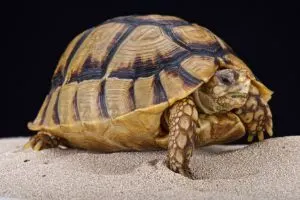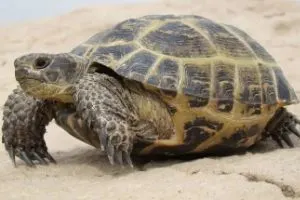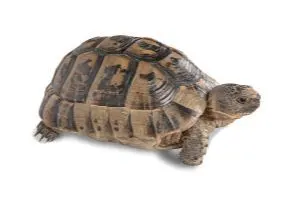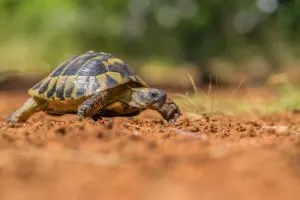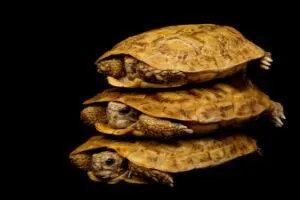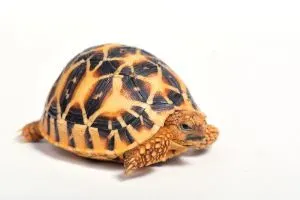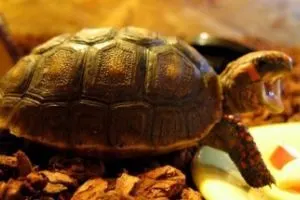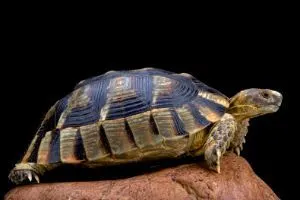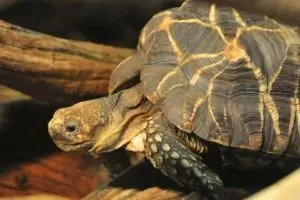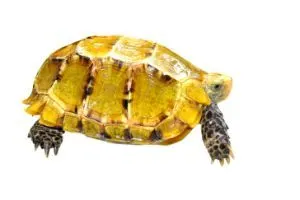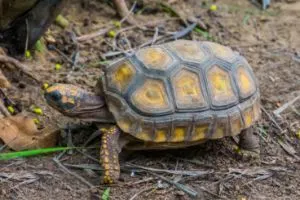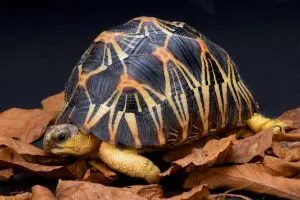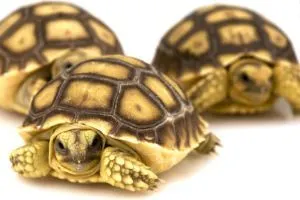Below you will find a few of the many different types of Tortoise Species. In order to make filtering easy we have categorized them from smallest to largest along with some highlights of each like colors and alternate names.
Before jumping in, here are some pages that you should find helpful
- Top 6 Best Pet Tortoises
- 6 Small Tortoises That Make Great Pets
- 7 Small Pet Turtle options (Aquatic)
- Turtle & Tortoise Identification Guide
- Cost of Turtle & Tortoise Ownership
- Is Your Tortoise A Boy Or Girl
- What Do Tortoises Eat?
- Can Tortoises Swim?
To learn more about each type of tortoise, just click on the image or title and you will be taken to a more in depth overview of the tortoise and how to care for the tortoise.
Tortoise Species by Size
Small (2 to 12 inches)
1. Speckled Tortoise
- Family: Testudinidae
- Genus: Chersoibius
- Binomial Name: Chersobius signatus / Homopus signatus
- Other Names: Speckled Padloper, Speckled Cape
- Size: 2.4 to 3.9 in (6-10 cm)
- Color: Goldish Beige with black spots and outlines on shell
- Lifespan: 100+ years
Speckled tortoises are the smallest species of tortoise in the world. These tiny tortoises are endemic to a specific region of South Africa; Little Namaqualand. They inhabit arid, rocky areas where they consume cacti and succulents. These herbivorous tortoises are classified as Endangered.
Speckled tortoises typically have gold-beige shells with black lines separating their scutes. Their shells sport a series of black speckles and are relatively flat with scalloped edges. Unlike many other tortoises, Speckled tortoises have five toes on each of their front legs.
2. Egyptian Tortoise
- Family: Testudinidae
- Genus: Testudo
- Binomial Name: Testudo kleinmanni
- Other Names: Kleinmann’s Tortoise, Leith’s tortoise
- Size: 5 in (13 cm)
- Color: Brown and Goldish yellow
- Lifespan: 70 to 100 years
Egyptian tortoises are a Critically Endangered species endemic to Egypt, Israel, and Libya. They are the smallest species of turtle found in the Northern hemisphere and inhabit semi-arid regions and deserts.
These rare tortoises have pale yellowish shells with dark triangular markings on each scute. They also have cream to dark brown plastrons. Egyptian tortoises are likely herbivores, although we know very little about their wild dietary habits.
Egyptian tortoises are part of the Cryptodira group of tortoises, also known as neck-hiding tortoises. These types of tortoise get their name because they withdraw their heads straight back into their shells rather than in a sideways motion like many other tortoises.
3. Russian Tortoise
- Family: Testudinidae
- Genus: Agrionemys
- Binomial Name: Afghan tortoise, Central Asian tortoise, Four-clawed tortoise, Horsfield’s
- Other Names: Horsefield Tortoise
- Size: 5-10 in (13-25 cm)
- Color: Black with Yellow
- Lifespan: 40 to 50 years
Russian tortoises inhabit the dry steppes and deserts of Central Asia, ranging from Russia to places like Afghanistan, Pakistan, and Uzbekistan. They favor regions with higher elevation and rocky ground. These tortoise are herbivores and eat various types of grasses.
Russian tortoises have tan to brown shells with black patches in the middle of their scutes and yellow to brown skin. One of the most astounding facts about these tortoises is that they were the first animals, including humans, to fly around the moon thanks to a Soviet space mission in the 1960s!
4. Greek Tortoise
- Family: Testudinidae
- Genus: Testudo
- Binomial Name: Testudo Graeca
- Other Names: Spur Thigh Tortoise
- Size: 5 – 11 in (13 – 28 cm)
- Color: Brown and Goldish yellow
- Lifespan: 50 to 125 years
Greek tortoises (and their 12 subspecies) are found across most regions of the Mediterranean, including coastal countries of North Africa. They inhabit dry, hot climates in rocky areas or semi-arid scrubland. They are a popular species to keep as a pet.
Greek tortoises have yellow to dark brown high-domed shells with dark mosaic-like patterning. They also have three spurs protruding from their thighs. These small tortoises like to burrow and dig to escape the hotter weather. They are herbivores and consume grasses and weeds.
5. Hermann’s Tortoise
- Family: Testudinidae
- Genus: Testudo
- Binomial Name: Testudo hermanni
- Other Names: Hermann’s turtle
- Size: 7.5 in (18 cm)
- Color: Black and gold yellow
- Lifespan: 75 years
Hermann’s tortoises are another popular species of pet tortoise, but this sadly has earned them Near Threatened classification. They are found across the Mediterranean as well as the southern parts of the Balkans. They inhabit semi-arid grasslands and dry forests or rocky areas. Hermann’s tortoises are herbivores, grazing on grasses and weeds.
Hermann’s tortoises have tan to light brown or yellowish shells with distinctive black markings. Their skin is usually light or dark brown. There are two subspecies which inhabit Eastern and Western areas respectively, and coloration will differ between regions.
6. Pancake Tortoise
- Family: Testudinidae
- Genus: Malacochersus
- Binomial Name: Malacochersus tornieri
- Other Names: Tornier’s Tortoise
- Size: 7 in (18 cm)
- Color: Brown and Gold yellow
- Lifespan: 25 years
Pancake tortoises are endemic to Kenya and Tanzania, where they inhabit rocky hillsides and arid bushland and savanna. Colonies of these flat-shelled tortoises often share the same rocky outcrop and are accomplished climbers.
As their name suggests, Pancake tortoises have flat brown shells that don’t have a completely solid bone structure like other tortoise shells. This makes the Pancake tortoise light and nimble compared to other species. Markings consisting of dark lines decorate each scute, while the plastron is yellowish in color.
Pancake tortoises are herbivores and graze on dry grasses. Unfortunately, these tortoises are Critically Endangered thanks to over-collection for the pet trade along with habitat destruction.
7. Gopher Tortoise
- Family: Testudinidae
- Genus: Gopherus
- Binomial Name: Gopherus polyphemus
- Other Names: –
- Size: 7.9 – 11 in (20 – 30 cm)
- Color: Dark Brown to Gray-black
- Lifespan: 40 to 100+ years
Gopher tortoises are one of the only tortoise species found in North America, inhabiting the southeastern United States. Across much of its range, the Gopher tortoise is listed as Threatened.
As a keystone species, the extensive burrows of Gopher tortoises provide a welcome refuge for around 360 other animal species during events like wildfires. These gentle reptiles are herbivores, grazing on over 300 species of plants.
Gopher tortoises have dark brown to gray shells, and adults often lack any specific markings. Their plastrons are yellow. To better adapt them for burrowing, Gopher tortoises have protective scales on their front limbs.
8. Hingeback Tortoise
- Family: Testudinidae
- Genus: Kinixys
- Binomial Name: Kinixys belliana
- Other Names: Hinged Tortoise
- Size: 9 in (22 cm)
- Color: brown black and yellow
- Lifespan: 20 years
Hinge-back tortoises are a group of several subspecies that are endemic to parts of sub-Saharan Africa. These tortoises all boast a 90 degree hinged section at the rear of their shells to help protect their legs.
Hinge-back tortoises vary in color from dark brown to black. Many subspecies have fluted edges to their outer scutes, especially towards the head. Some types of Hinge-back tortoises will have various markings ranging from tan to black.
Hinge-back tortoises prefer sub-tropical or tropical regions and inhabit a wide variety of habitats within those areas. All subspecies of the Hinge-back tortoise are omnivorous. While they mainly eat plant matter, they will also consume insects, worms, and other protein sources as well.
9. Indian Star Tortoise
- Family: Testudinidae
- Genus: Geochelone
- Binomial Name: Geochelone elegans
- Other Names: –
- Size: 10 in ( cm)
- Color: Goldish Yellow and Black
- Lifespan: 30 to 80 years
Indian Star tortoises are a vibrant, distinctive species native to parts of India, Pakistan, and Sri Lanka. Due to their beautiful appearance, these sought-after tortoises are now sadly endangered thanks to over-collection for the pet trade.
Indian Star tortoises have high-domed dark brown or black shells with dazzling yellow or orange radiating lines. This species will often have humps on the top of its shell. These patterns help to camouflage the tortoise in dense grass.
These stunning tortoises inhabit dry grassy areas or forests and eat a mainly herbivorous diet. Occasionally they will also feed on carrion. They are part of the Cryptodira group of tortoises, also known as neck-hiding tortoises. They retract their heads straight into their shells when threatened.
10. Elongated Tortoise
- Family: Testudinidae
- Genus: Indotestudo
- Binomial Name: Indotestudo Elongata
- Other Names: Yellow-headed Tortoise
- Size: 12 in (30 cm)
- Color: Black and Goldish yellow
- Lifespan: 40 to 50 years
Elongated tortoises are endemic to regions of the Indian subcontinent and Southeast Asia such as Bangladesh, Cambodia, China, Thailand, and Vietnam. They inhabit humid tropical forests and will hide themselves among the leaf litter on the forest floor.
Elongated tortoises have long, narrow tan to yellow shells with pale yellow heads. Some individuals may also have dark brown markings on their shells. These tortoises also have light brown or yellow skin with a grayish tinge.
This species is relatively docile and can make good pets. Elongated tortoises have an omnivorous diet in the wild. While they prefer to eat plants and other vegetation, they will occasionally eat carrion.
Medium (13 – 24)
11. Desert Tortoise
- Family: Testudinidae
- Genus: Gopherus
- Binomial Name: Gopherus agassizii
- Other Names: Desert Turtles
- Size: 10 – 14 in (25 – 36 cm)
- Color: Greenish-tan to dark brown
- Lifespan: 50 to 80 years
Desert tortoises are native to southwestern desert areas of the United States as well as parts of Northern Mexico. These slow-growing tortoises are unfortunately classed as Vulnerable due to habitat loss throughout its native range.
Desert tortoises have large domed shells which range from dark brown to yellowish brown to green, and their scutes usually have light patches. This species spends almost 95% of its life escaping the sweltering heat in underground burrows, which also provide a welcome refuge for other animals.
These medium-sized tortoises are herbivores and will graze mainly on grasses, herbs, and wildflowers. Thanks to their specialized bladders, Desert tortoises can go up to a year without drinking if necessary.
12. Red Footed Tortoise
- Family: Testudinidae
- Genus: Chelonoidis
- Size: 12 – 16 in (30 – 40 cm)
- Color: pale yellow to brick red
- Binomial Name: Chelonoidis carbonaria
- Other Names: Red-Foot tortoise, Red-Leg tortoise, Red-Legged tortoise, Savanna tortoise
- Lifespan: 50 years
Red-footed tortoises are natives of the northern regions of South America. There are between five and seven recognized regional subspecies, with different variations existing north and south of the Amazon basin. They inhabit hot and humid regions that straddle forests and scrubland.
Red-footed tortoises have dark brown loaf-shaped carapaces with yellow or red spots in the center of their main scutes. Their dark brown legs have reddish scales, and there are also have red patches on their heads and cheeks.
These medium-sized tortoises are omnivores, mainly eating a diet of fruits, grasses, and occasionally protein foods such as worms.
13. Marginated Tortoise
- Family: Testudinidae
- Genus: Testudo
- Binomial Name: Testudo Marginata
- Other Names: Greek Marginated tortoise
- Size: 14 in (35 cm)
- Color: Brown and Goldish yellow
- Lifespan: 100 to 140 years
Marginated tortoises are a medium-sized species found in parts of the Mediterranean, ranging from southern Greece to the Balkans, Italy, and northern Sardinia. These herbivorous tortoises inhabit colder mountainous, rocky regions of high elevation where they can burrow.
Marginated tortoises have distinctive oblong shells that are almost entirely black with some yellow markings. This helps the tortoise to absorb as much heat as possible in the cold climate of their surroundings. The back part of their shells don’t divide over the tail. Instead, the rear scutes are fluted and jut upwards.
14. Burmese Star Tortoise
- Family: Testudinidae
- Genus: Geochelone
- Binomial Name: Geochelone playtona
- Other Names: –
- Size: 14 in (35 cm)
- Color: Goldish Yellow and gray
- Lifespan: Approximately 30 to 80 years
Burmese Star tortoises are a Critically Endangered species endemic to Myanmar (formerly known as Burma). These tortoises are often eaten by local people, which has contributed to their endangered status. Burmese Star tortoises inhabit deciduous forests in drier regions of Myanmar.
Burmese Star tortoises have beautiful star-shaped patterns that radiate from the top of their dark brown or black shells, continuing down the high-domed carapace in colorful yellow lines. Their skin and heads have yellow or tan coloration. This is a herbivorous species that prefers larger leaves.
15. Impressed Tortoise
- Family: Testudinidae
- Genus: Manouria
- Binomial Name: Manouria impressa
- Other Names: –
- Size: 14 in (35 cm)
- Color: Yellow, brown, redish
- Lifespan: unknown
Impressed tortoises are a Vulnerable species endemic to high altitude mountainous regions of Southeast Asia. They are found in countries such as China, Myanmar, Malaysia, Thailand, and Vietnam. Unfortunately, these tortoises are often eaten by local people as well as being threatened by habitat loss.
Impressed tortoises have yellowish brown shells that have indented or impressed scutes. Skin coloration is usually yellowish to dark brown with more yellow on their heads. Their front scutes are elongated while their rear scutes are serrated.
In their mountainous habitats, Impressed tortoises seem to prefer areas with forests. They will forage for bamboo shoots and mushrooms as part of a herbivorous diet.
16. Angonoka Tortoise
- Family: Testudinidae
- Genus: Astrochelys
- Binomial Name: Astrochelys yniphora
- Other Names: Madagascar (angulated) tortoise, Ploughshare tortoise, plowshare tortoise
- Size: 15 – 17 in (38 – 43cm)
- Color: Light brown and yellow
- Lifespan: Approximately 188 years
Angonoka tortoises are a Critically Endangered species endemic to a small region in northwestern Madagascar. Less than 400 wild specimens may remain. Angonoka tortoises inhabit dry forest regions where they graze on a herbivorous diet of grasses, herbs, and dead leaves.
These incredibly unique tortoises have tall, high-domed shells with rounded protruding scutes on the top and sides. Coloration ranges from tan to yellowish brown and dark brown. Some individuals may have dark brown to black triangular markings.
Forest fires, habitat loss, predation, and collection for the pet trade all pose significant dangers to the dwindling population of the Angonoka tortoise.
17. Yellow Foot Tortoise
- Family: Testudinidae
- Genus: Chelonoidis
- Binomial Name: Chelonoidis Denticulatus
- Other Names: Big turtle, Brazilian Giant tortoise, Brazilian Giant turtle
- Size: 16 in (40 cm)
- Color: Black and Goldish yellow
- Lifespan: 50 to 60 years
Closely related to the Red-footed tortoise, Yellow-footed tortoises are found in areas of the Amazon basin where humid rainforest margins meet more open grassland regions. Yellow-footed tortoises mate throughout the year and will leave their offspring to fend for themselves.
Yellow-footed tortoises have dark brown to yellow shells with black edges to the carapace. These tortoises have relatively long bodies compared to their width. On their head and limbs, the skin is black with orange or yellow scales.
These tortoises are omnivorous and will forage mainly for plant matter and vegetation along with carrion and mollusks such as snails and worms.
18. Radiated Tortoise
- Family: Testudinidae
- Genus: Astrochelys
- Binomial Name: Astrochelys radiata
- Other Names:
- Size: 16 in (40 cm)
- Color: Yellow, orange, and black
- Lifespan: 100to 188 years
Radiated tortoises are a Critically Endangered species endemic to southern regions of Madagascar. Habitat destruction and poaching have cause the numbers of the Radiated tortoise to drop, although some populations have been reintroduced in islands such as Reunion and Mauritius.
These beautiful tortoises inhabit dry bushland areas and woodlands. Radiated tortoises have high-domed dark brown shells decorated with their eponymous patterns of orange or yellow radiating lines. They have smoother scutes than other similar species.
Radiated tortoises are herbivores and mainly graze on grasses as well as fruits and succulents.
Large (25 and above)
19. Leopard Tortoise
- Family: Testudinidae
- Genus: Chordata
- Size: 27 in (69 cm) long / 18 in (46 cm) tall
- Color: Black with Gold similar to a leopard
- Binomial Name: Stigmochelys pardalis
- Other Names: Giant Leopard tortoise
- Lifespan: 50 to 100 years
Leopard tortoises are Africa’s second-largest tortoise species native to eastern and southern regions such as South Sudan, Somalia, Namibia, and South Africa. They inhabit dry grasslands and savannas and don’t tolerate humid conditions.
Leopard tortoises have intricate black and yellow spots across their high-domed shells. These patterns expand as the specimen gets older. Their skin is typically brown or tan colored.
These large tortoises are herbivores and mainly graze on dry grasses and occasional succulents. In extreme hot or cold climates, Leopard tortoises will hide in the burrows of other animals. This species only digs when constructing nests for its eggs.
20. Sulcata Tortoise
- Family: Testudinidae
- Genus: Centrochelys
- Binomial Name: Centrochelys sulcata
- Other Names: African Spurred Tortoise
- Size: 33 in (83 cm)
- Color: Black and Yellow
- Lifespan: 70 to 100 years
Sulcata tortoises are the largest mainland tortoise species in the world and are found in the southern Sahara desert region in Africa. They will also inhabit dry grasslands and savannas where they can graze on grass.
These gentle giants have high-domed yellow to brown shells with large, thick scutes. Their skin ranges from cream to tan to brown and their legs are covered in bony spurs. Exceptionally large Sulcatas can weigh up to 200 lbs.
Sadly, Sulcatas suffer thanks to misinformation in the domestic pet trade. Baby Sulcatas are marketed as a small species, and most owners are totally unprepared for the giants that these reptiles will become. Sulcatas are often abandoned to the care of rescue centers in the United States.
21. Aldabra Tortoise
- Family: Testudinidae
- Genus: Aldabrachelys
- Binomial Name: Aldabrachelys Gigantea
- Other Names: Seychelles Giant Tortoise
- Size: Average 48 inches (122 cm) in length
- Color: Brown or Tan
- Lifespan: 200+ years
Aldabra Giant tortoises are impressive behemoths that are endemic to the Aldabra Atoll situated in the Seychelles in the Indian Ocean. These massive tortoises are sadly classed as Vulnerable, although conservation efforts have been in place since the 19th Century.
Aldabra tortoises have high-domed brown shells with large scutes. Their thick legs and long necks enable them to graze on lower hanging tree branches. This mighty species eats a herbivorous diet but may sometimes eat carrion as well.
These giant reptiles actually have a drastic effect on their local ecosystem. Like elephants, Aldabra tortoises clear vegetation for other animals. Because of their feeding habits, a unique ecosystem has sprung up in Aldabra territory known as “tortoise turf”; a mix of grasses and plants that have evolved to grow their seeds close to the ground.
22. Galapagos Tortoise
- Family: Testudinidae
- Genus: Chelonoidis
- Size: 24 – 59 in (61 – 150cm) varies on islands
- Color: blackish gray
- Binomial Name: Chelonoidis Nigra
- Other Names: –
- Lifespan: 100+ years
Famous around the world, Galapagos tortoises are the largest species of tortoise on Earth. These incredible animals are native to seven islands in the Galapagos archipelago in Ecuador. Because these islands have slightly different habitats, shell size varies considerably across specific island individuals.
Galapagos tortoises have dark brown to gray to black shells that resemble saddles. These tortoises were named by Spanish explorers in the 1500s, and the name “Galapagos” derives from the Spanish word for “saddle”. Some individuals can get as big as 5 feet long.
There are 12 surviving subspecies of the Galapagos tortoise, each inhabiting their own area of one of the Galapagos islands. Some of these subspecies are Critically Endangered, but all are threatened by habitat loss.
Galapagos tortoises eat a herbivorous diet and spend hours each day grazing on grasses, cacti and fruits.


